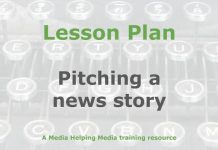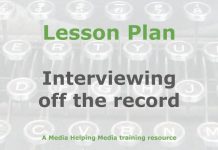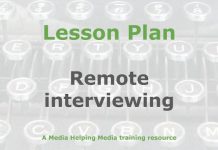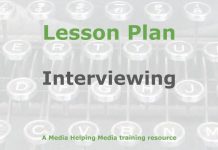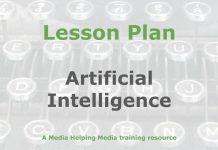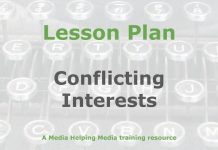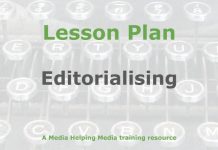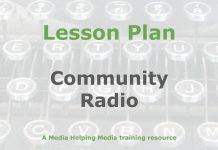 Television journalists need to ensure that they are exploiting the medium to the maximum effect by letting the pictures tell the story.
Television journalists need to ensure that they are exploiting the medium to the maximum effect by letting the pictures tell the story.
This lesson plan is based on the article ‘Letting the pictures tell the story‘ which is published on Media Helping Media and which we recommend you read before adapting this lesson plan for your own purposes.
Learning objective
Students will analyse and sequence visual elements to construct a coherent narrative in a television report. They will evaluate the effectiveness of images in conveying the story without relying heavily on verbal explanations.
- Student-facing objective: By the end of this lesson the student will be able to use pictures to tell a story in a TV report, making sure the images speak for themselves.
- Standards: Television reporting involves letting the pictures tell the story wherever possible.
Learning activities
Warm-up
Show students a series of three unrelated images. Ask them to jot down a short story that connects these images. Then, have students share their stories with a partner. Encourage them to discuss how the images influenced their narrative choices. This activity primes students to think about how images can drive storytelling, setting the stage for the lesson’s focus on letting pictures tell the story.
Direct instruction
- Introduce the concept: Explain the importance of letting pictures tell the story in television reporting. Use a real-world example, such as a news segment, to illustrate how images can convey emotions and context without words. Discuss how this approach differs from traditional reporting methods that rely heavily on narration.
- Analyse a news package: Present a short, pre-selected news package that effectively uses images to tell a story. Ask students to identify key shots and discuss their impact. Guide them to consider the sequence, duration, and transitions of the shots. Use questions like: “What emotions do these images evoke?” and “How do the images enhance the narrative?”
- Sequence activity: Provide students with a set of still images from a fictional news story. Instruct them to arrange the images in a sequence that tells a coherent story. Encourage them to think about the opening and closing shots, as well as the flow between images. Facilitate a class discussion on the different sequences created and their narrative effectiveness.
Guided practice
Think, Pair, Share: Guide students through a collaborative activity to reinforce the concept of using images to tell a story.
- Think: Present a series of images from a news event. Ask students to individually think about the story these images could tell.
- Pair: Have students pair up to discuss their individual interpretations. Encourage them to compare their narratives and identify common themes or differences.
- Share: Invite pairs to share their stories with the class. Facilitate a discussion on how different interpretations can arise from the same set of images. Highlight the importance of image selection and sequence in storytelling.
- Feedback: Provide constructive feedback on how well the images were used to convey the story. Encourage students to consider alternative sequences or additional images that could enhance the narrative.
- Reflection: Ask students to reflect on how this exercise has changed their understanding of visual storytelling. Encourage them to consider how they might apply these skills in future projects.
Independent practice
- Image analysis exercise: Provide students with a set of images from a news event. Instruct them to individually analyse each image, noting key elements that contribute to the story. Encourage them to consider aspects such as emotion, context, and action.
- Storyboarding task: Ask students to create a storyboard using the analysed images. They should sequence the images to form a coherent narrative, focusing on the flow and transitions. Encourage them to think critically about the opening and closing shots.
- Peer review: Pair students to review each other’s storyboards. They should provide feedback on the narrative clarity and suggest improvements. Encourage them to discuss how the images could be rearranged for better storytelling.
- Reflection: Have students write a brief reflection on how the exercise helped them understand the role of images in storytelling. Encourage them to consider how they might apply these skills in future projects.
Circulate to observe and support students as needed.
Assignment
Ask students to answer these questions:
- How did the sequence of images affect the story you created?
- What was the most challenging part of using images to tell a story?
- Is there anything you don’t understand following this training?
Here are some suggested answers:
- Suggested answer to Question 1: The sequence determined the flow and emotional impact of the story, guiding the viewer’s understanding.
- Suggested answer to Question 2: Ensuring each image contributed meaningfully to the narrative without relying on text or dialogue.
Teacher resources
Differentiation guide
- Advanced learners: Encourage them to explore more complex narratives by incorporating additional images or experimenting with unconventional sequences. Challenge them to create a story with minimal or no text, relying solely on visual elements. Suggest they analyse professional news packages for advanced techniques in visual storytelling.
- Striving learners: Provide additional support by offering a simplified set of images with clear, sequential cues. Use guided questions to help them identify key elements in each image. Pair them with peers for collaborative sequencing activities, allowing them to learn from others’ interpretations. Offer examples of effective image sequences to illustrate concepts.
- Background reading: This lesson plan is based on the article ‘Letting the pictures tell the story‘ which is published on Media Helping Media and which we recommend you read before adapting this lesson plan for your own purposes.
Notable definitions
- Visual narrative: The use of images to convey a story or message without relying on text or spoken words. It emphasises the power of visuals in storytelling.
- Shot sequence: The order in which images or video clips are arranged to create a coherent and engaging narrative. It involves selecting the right sequence to enhance the story’s flow and impact.
- Stand-up (piece-to-camera): A segment in a television report where the reporter speaks directly to the camera, often used to provide context or emphasize key points in the story.
Required materials
- Images: A set of still images from a fictional news story for sequencing activities.
- Video clip: A short, pre-selected news package for analysis.
- Storyboard templates: Blank templates for students to arrange images and create storyboards.
- Writing materials: Paper and pens for jotting down notes and reflections.
- Projector/screen: For displaying images and video clips to the class.
- Computers/tablets: Optional, for digital storyboard creation and image analysis.
Lesson summary
- Warm-up
- Direct instruction
- Guided practice
- Independent practice
- Assignment
The free teaching tools at the Khan Academy were used in the production of this lesson plan.
Related article
